This week we’re looking at bass chords. When you first learn chords you generally learn chords from the root note upwards. But we can learn chords starting from other chord tones like the 3rd or 5th. These are inversions and can help create great voice leading in the bass line.
Basic Chords
OK so I’m going to assume a little bit of knowledge on your part for this lesson. I’m assuming a knowledge of the basic triads and seventh chords on the bass. If you don’t know them then check out the following bass lessons:
Inversions
So let’s now look at inversions. What is an inversion? Well an inversion is a chord played from a note other than the root note.
So let’s look at the notes of the C major triad:
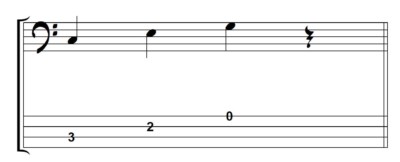
We have C E and G. They are the root note, the major 3rd and the perfect 5th. But those chords can be laid out in a multitude of different ways on an instrument. As long as we have those 3 notes in there it’s a C major of some kind.
So even as an arpeggio we could play them as C E G or E G C or G C E (see below). These are inversions.
So if we start on the root note C that would be what’s called a root position triad. C E G:

If we start that series of notes on an E the third (E G C) that’s called first inversion:
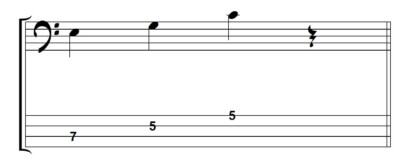
If we start at the 5th G (G C E) we have what’s called second inversion:
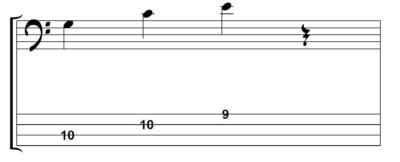
We can continue this method for seventh chords, 9th chords, 11th chords and 13th chords. Start at the 7th and it’s third inversion, the 9th and it’s fourth inversion and so on.
Playing Chords
Now we can play chords one note at a time as an arpeggio but in dealing with chords we don’t have to worry as much about the ordering of the notes in an inversion.
The only thing that we need to be aware of is the lowest note, the bass note. If we have the root note is the lowest note then it’s root position. If the third is the lowest note then it’s first inversion. If the fifth is the lowest note then it’s second inversion. The other notes can be voiced in many different ways depending on things like the melody or the required voice leading. Just remember, the bass note (the lowest note) determines the inversion.
Fretboard Patterns
So now let’s look at some inversion shapes for the bass. I’ll build each chord from a root note of C and we’ll start with the Major and Minor Triads:


Now let’s look at the Seventh Chords:



Chord Progression
So that’s the chords, now here we have a short progression using those inversions in the key of C. The fingerpicking pattern is demonstrated in the video. Follow the chord fingerings in the tab below:
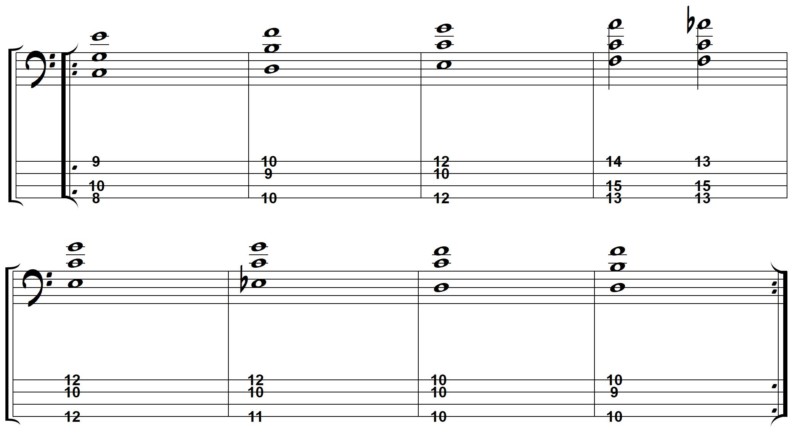
So that’s inversions. They have a really cool sound and can make a big difference when looking to create a bit of variety in the voice leading and bass movement. So try them out, experiment with them in as many progressions as possible.











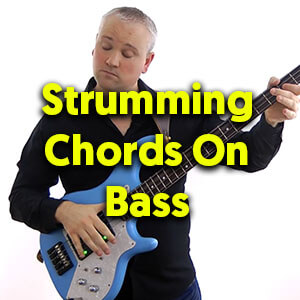
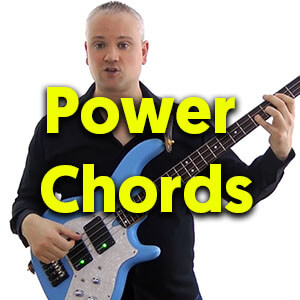
I find your tuition very easy to follow, you don’t rush things or show off your ‘amazing’ skillIs that frighten learners to death! I started to learn the bass when I was 78, I am now 81. It came about because I wanted to learn to play a ukulele but within a few months of everybody in the pub group I was in all strumming in the same pattern, I got bored. As I always listen to the bass lines in music I had a U-bass for Christmas. Having tried other in-line tutorials I was fortunate to come across yours and can follow your lessons quite comfortably. I am not as flexible finger wise as I would like to be and so I have settled on doing simple things well rather than trying fancy stuff badly. Thanks again for your help.
IGreat. Very structured and easy to follow lessons.
EDnjoyed lesson and nice presentation – Thanks
Wow, u are good teacher indeed, kudos
Again an excellent lesson from theory basics all the way to application. A bit “tricky” the way you made my brain smoke at bar number seven!
Took some time to find out that you play and explain a D7 while there’s a Dmin7 written on the sheet. Did not realy match my playing. You could play it like that, yeah, but I prefer this beautiful chromatic line coming down from G over F# to F and E.
Holy cow, I eat my words! The longer I play this inversion, the longer I practice, the more I like and feel that written version with its touch of sadness due to the minor chord.
Just try to improvise singing over that progression. Only few things can make you feel better.